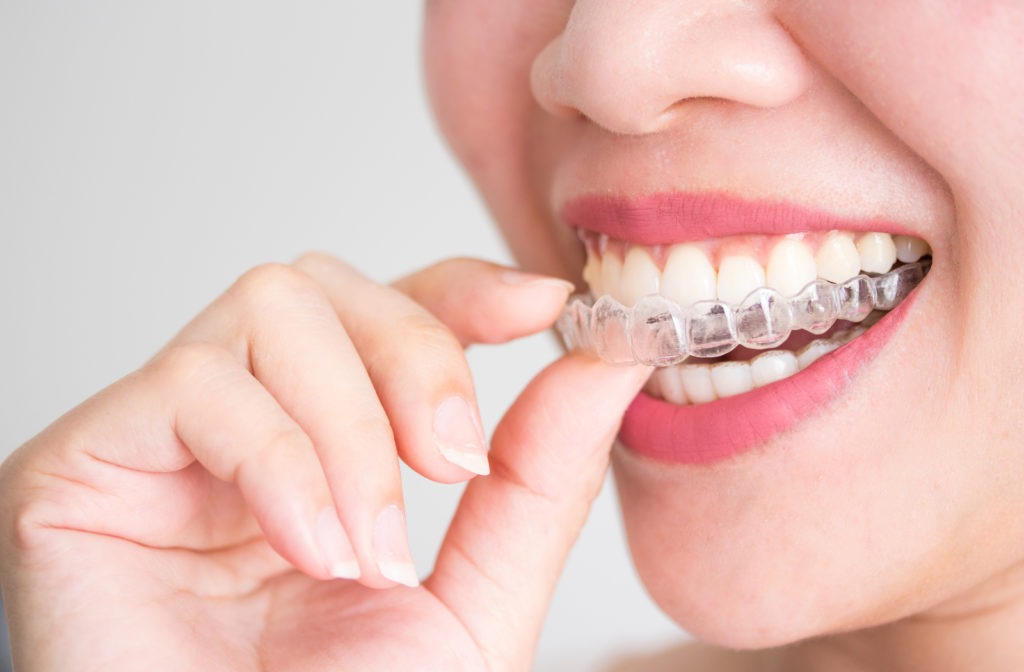Invisalign offers dental patients the ability to slowly reposition their teeth without drawing attention to a visually-obvious orthodontic device. Many people prefer the idea of using Invisalign to wearing braces, due to their relative comfort and lower profile. But how does Invisalign compare to traditional braces when it comes to speed?
Our practice has spent years providing orthodontic treatments (including Invisalign, braces, and functional orthodontics) to patients of all ages. As a result, we’ve had ample opportunity to see how standard braces and Invisalign stack up to each other. Read on as we tell you more about how long it takes for Invisalign to change the alignment of a person’s teeth and why, so you can make informed decisions about the products you use.
What Is Invisalign?
Invisalign uses a series of clear aligners to shift the position of a person’s teeth over a gradual period of time. The plastic used to make these aligners is a specific type of thermoplastic called SmartTrack, which is used exclusively by Invisalign to promote flexibility. This flexibility allows the aligners to fit a wide range of teeth snugly and effectively.
The clear aligners used for Invisalign are designed based on a 3D model of your teeth. After taking the scan needed for this model, your dentist will send the images of your teeth to Invisalign, who will manufacture your custom aligners.

Key Differences Between Invisalign & Traditional Braces
Many people assume that Invisalign aligners are just transparent braces, but there are numerous differences between these two technologies:
No Brackets or Wires
Unlike braces, Invisalign aligners are completely wireless. This also helps prevent the discomfort that some people experience when their braces are adjusted by an orthodontist.
Less Discomfort
Because Invisalign liners have no wires or brackets, they are less prone to breaking or coming loose inside the mouth. This saves patients from poking or cutting the soft tissues in their oral cavities, and results in fewer trips to the dentist to have these defects addressed.
Removable
Once braces have been fit to a patient’s teeth, they must be worn day and night until they are ready to come off. Conversely, Invisalign liners can be removed for activities such as eating, drinking, brushing, and flossing. Some patients also take their aligners out for special occasions, but since the aligners are clear, they are difficult to notice even when worn during events and gatherings.
How Effective Is Invisalign vs. Traditional Braces?
The speed at which Invisalign can change the alignment of your teeth depends on how extensively they need to be moved. However, in most cases, clear aligners have been associated with shorter treatment durations than braces, with results beginning to appear in under 6 months for some patients.
By comparison, most braces must be worn for 1 to 3 years. However, it should be noted that Invisalign can take considerably longer to shift a patient’s teeth effectively if the aligners are not worn as recommended by your orthodontist.
Finally, be advised that patients with severely misaligned teeth may not be suitable candidates for Invisalign. Traditional braces can sometimes outperform Invisalign when it comes to adjusting factors like teeth torque and retention.
Invisalign Offers Clear Benefits
Invisalign can help many people improve the alignment of their teeth without the discomfort and potentially-awkward appearance of braces. However, wearing Invisalign is only more effective than braces when patients wear their aligners diligently and follow the advice of qualified dental professionals.
Learn more about Invisalign by contacting our practice and asking to speak with a member of our team. We will be delighted to help you choose the right kind of orthodontic device for your mouth and lifestyle.


